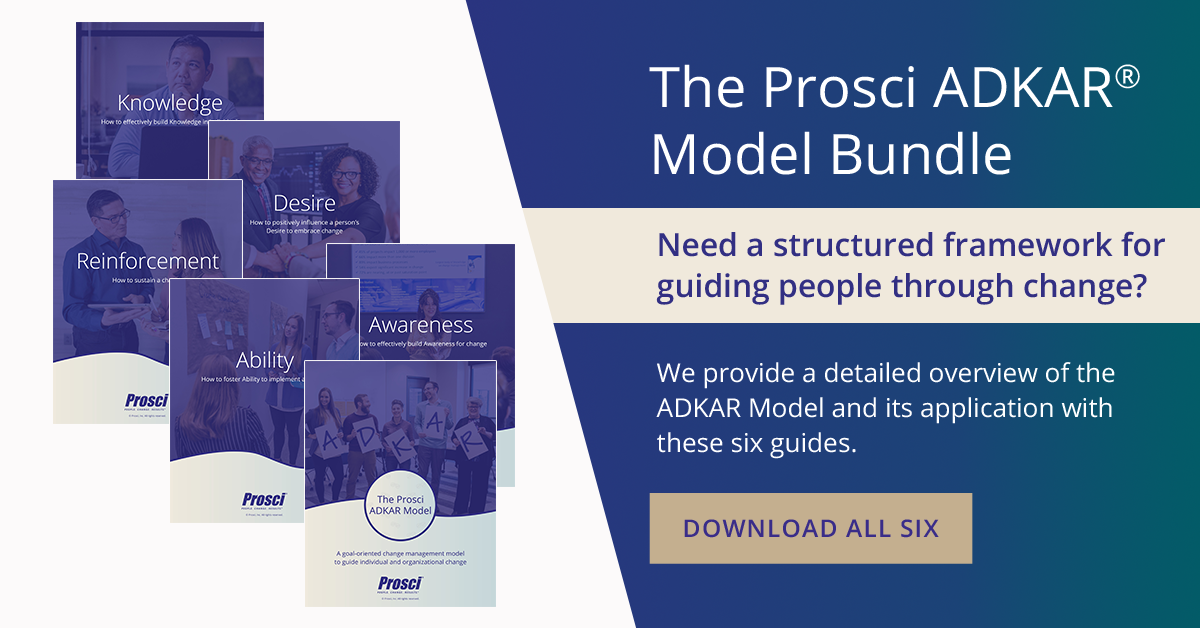Change Management in Customer Success

4 Mins
Updated: August 8, 2024
Published: February 29, 2020

Within the software-as-a-service (SaaS) industry, customer success professionals focus on building customer loyalty, ensuring retention and growing installed-base revenue. As with the change management discipline, promoting adoption and usage of the software solution is critical to customers achieving their intended results and ROI. Given this, why isn’t the people side of change a key part of customer success roles today?
Customer Success and Churn
The customer success discipline grew out of the need for subscription software companies to curb runaway churn and increase customer loyalty. Whenever customers decide not to renew their software subscriptions—a problem known as churn―revenue losses multiply. This “leaky bucket” of recurring revenue is a significant issue for SaaS companies because they must acquire more and more new customers just to stay in place.
Selling to new customers is also extremely expensive. According to the KBCM Technology Group’s 2019 survey, median new customer acquisition costs for SaaS companies were a staggering $1.34 for every dollar of first-year recurring revenue. This means companies must retain their customers for the long term if they want to turn a profit.
The customer success manager’s job is to onboard new customers, making sure the buyer adopts and uses the solution, so they achieve their intended benefits. Along the way, the customer success manager ensures a satisfactory experience, and later, actively works to get the customer to renew and expand their subscription.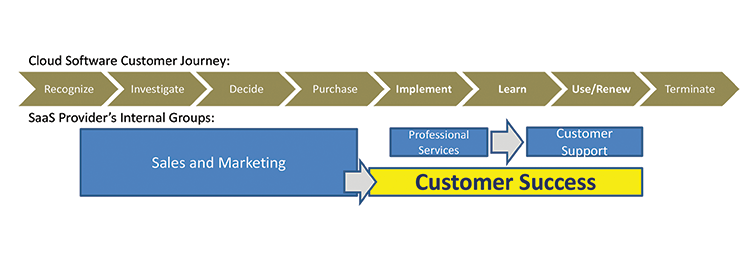
Why Saas Companies Don't Commonly Apply Change Management
If you think the adoption and usage issues in customer success mirror the people-side issues change managers address, you’re right. Yet, change management is not commonly applied in the SaaS industry. Here are three reasons:
The software buying model is different
The former software model was for customers to purchase software and install it on servers on their premises. Examples include large ERP or accounting software systems. These purchases typically went through the IT department, which managed the rollout from a centralized office or PMO with change management teams working alongside them.
Now software is largely subscription-based, and organizations buy many applications without first going through the PMO or IT offices. Buyers are in marketing, sales, engineering, customer support and other functional areas that are typically unfamiliar with change management.
The industry is different
Unlike some massive, on-premises software providers like Microsoft, who understand and use change management, today’s early-stage SaaS companies are led by software developers who tend to lack that exposure. Technical entrepreneurs operate largely on the assumption that a new and better mousetrap will attract buyers, and that people will immediately adopt and use a great product. Some SaaS companies do this with great success, but most do not.
The language is different
Software developers use the term “change management” commonly, but they typically mean something different. Software developers assume it means changing versions of software code from one version to the next (e.g., from software build 1.4.14 to 1.4.15). And in the information security world, change management means replacing infrastructure, deploying software revisions, or updating security policies as required by ISO/IEC 27001 standards.
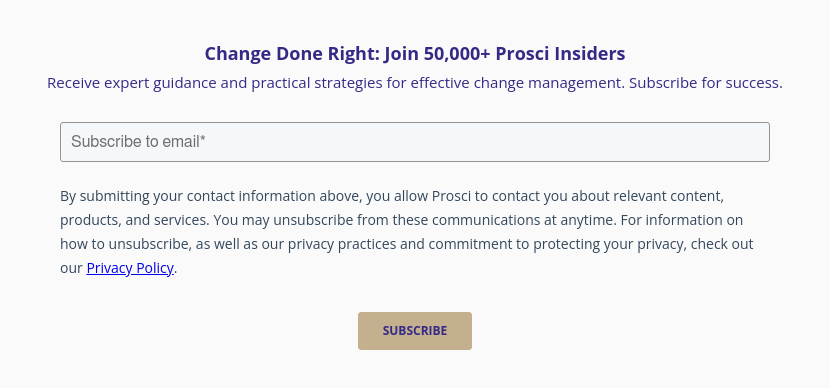
How to Use the ADKAR Model to Bridge Gaps in Customer Success
The SaaS industry assumes that getting people to use the software on a large scale will produce the business results the buyer intended to achieve, and onboarding includes training to ensure that users know how to use it. In ADKAR terms, they do the K well―but miss the A, D, A and R. In fact, few in the industry know what these letters represent, let alone their importance.
When introducing the concept to the software community, customer success managers must first introduce the ADKAR Model to clearly distinguish the people-side definition of change management from other meanings.
Prosci ADKAR Model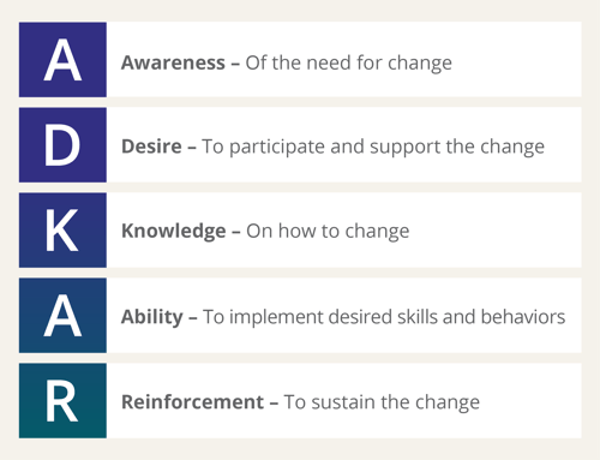
Similarly, the customers in functional areas who purchased the software product without involvement from their IT department may not understand the need for change management. For example, the marketing manager buys a new cloud-based application for the department, but employees don’t use it, so they eventually cancel the subscription. They miss the people side of increasing adoption and usage.
To resolve this, customer success managers must work alongside the professional services team, as well as the customer’s project manager and executive sponsor to deploy cloud-based technologies while addressing the critical people-side issues.
What SaaS companies are learning today is that there’s much more behind why customers choose to either renew or churn. People must use the product. They must adopt it and get results from it. And they must be satisfied with multiple aspects of working with the company that sold it to them. The mechanics of change from a human perspective is essential to everything that customer success is trying to accomplish.
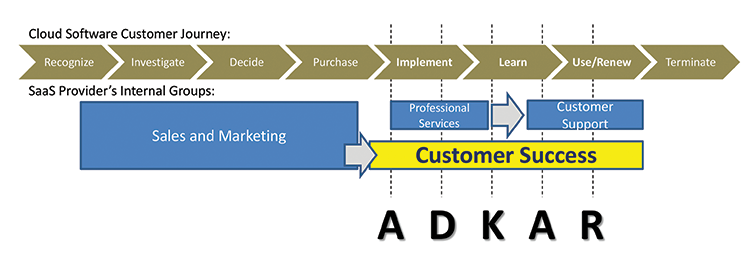
The ADKAR Model is helpful because it shows customer training alone isn’t enough. The path from buying intention to business results requires a fundamental change in human behavior.
Ultimately new software users must have an Awareness of the “what” and the “why.” Why did we buy this? What problem are we trying to solve? Why this? Why now? And what's the cost of not going along with it? That's often overlooked.
And building that Desire or “What's in it for me?” How is this going to make my life better or different?
And finally, building and reinforcing skills until usage becomes habitual. For SaaS, this creates that magical application “stickiness” all entrepreneurs want: the product delivers its promised value, leading users to avoid switching to something else.
Improve Customer Success
With Change Management
When I talk to people in my community, I frequently describe the need for customer success managers on the front line and customer success leadership to understand the people side of change. Adoption means more than just doing the technical integration, deployment and training. It’s about getting users to change their behavior. There’s a huge opportunity for sellers of software, particularly within the SaaS community, to pay close attention to change management and how it works in tandem with customer success.
Ironically, the SaaS industry must undergo its own ADKAR journey to adopt people-side change management in day-to-day practices. SaaS company executives and investors must become Aware of change management’s contributions, Desire the results it delivers, gain Knowledge of the process, develop the Ability to change their own organization’s processes, and Reinforce the ongoing practice of change management within the customer success ranks.

